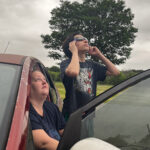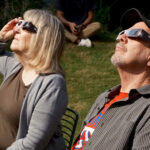
By Tammy Busby
The San Antonio River, known to the Coahuiltecan Indians as Yanaguana, stretches out into a lazy flow of lifegiving water to egrets, ducks, turtles and other wildlife to the south including small mammals, deer and javelina. I have spent many wonderful hours with my family enjoying this stretch of the river, on foot and on bicycles. The missions are San Antonio’s hidden jewels.
***
After weeks of cranky winter weather, it’s a clear blue-skied, cloudless day in San Antonio. At last, a weekend to get outside. Experiences are what my family and I are looking for — opportunities to work or play that give us a chance to stretch ourselves individually, but also as a team. As a single mom in today’s economic climate, I look for things that bring my family together and are inexpensive or cost nothing at all. Sometimes we look for pure entertainment, but more often, we find ways to become involved with the community and to connect with the history of San Antonio.
There is nothing that can beat the sense of adventure that carries us down the Mission Trail, as though the river itself flows through our imagination; we become cowboys on a trail ride with our bicycles as our steeds, or merchants of hope with baby strollers as handcarts and wagons, pioneers on a spiritual mecca for health and peace.
I have spent many wonderful hours with my family enjoying this stretch of the river, on foot and on bicycles. The missions are San Antonio’s hidden jewels.
New Priorities Overtake Neglect
Until the late 1990s, the role of the missions in our area’s historic beginnings have been largely ignored, not just by residents, but by developers and city leaders. But now the City of San Antonio, Bexar County, and the San Antonio River Authority, along with the National Park Service and the Army Corp of Engineers have joined forces and reserved $353 million ($275 million earmarked for the Mission Reach portion) for a multi-phase river improvement project. This project was designed to restore historical connections, create recreational opportunities and address the ecosystem of the San Antonio River.
The recently completed Museum Reach phase of the project is proving to be an economic boon for businesses along the stretch of river from downtown to the Witte Museum. Tourists can now enjoy an extended boat ride from downtown to the Pearl Brewery to enjoy art galleries and an outdoor farmer’s market.
But, what about Mission Reach?
South Side Explorations
I obtained a bike map from Centro San Antonio, a partner organization of the Downtown Alliance, a non-profit organization dedicated to making downtown San Antonio a better place to live, work, eat and play. I set out on my motor scooter to have a look at the 8-mile Mission Reach phase, and made some interesting discoveries. It is not exactly easy to get to, even by roadway. A thriving city has grown up around the trail system.
Because the South Side is an area plagued by crime, with lower household incomes and lower home values than the other areas of the city, it is important to reconnect residents with the historical roots of the city. Revitalization of areas around the project through rezoning and an infusion of interest and investment from nonprofits and the City of San Antonio represent an important social acknowledgement of the working-class people who live and work there. It promotes a sense of pride and belonging and has fostered longterm care for the missions.
At the ancient aqueduct, I met Frances and Chris Chavez, a young San Antonio couple enjoying a bike ride from downtown to the south end of the mission trail with two friends enrolled at UTSA.

Frances, a nurse at Christus Santa Rosa Hospital, said that in its current stage of development, the Mission Reach trail seems a bit dangerous because the bike lanes start and stop in so many places. She doesn’t like to bike with traffic. Her husband and friends agreed that the south reach is special because it feels like a different place. The trail, she said, is a taste of history and a wonderful place to take a break from the hectic life of work and school.
In the Mission Reach, the manicured landscape seen on the Riverwalk is replaced by natural areas of rolling hills of switchgrass and groves of oak and mesquite. The chatter of tourists is replaced by the chirping killdeer, wrens and swallows, and if you’re lucky, the call of the great blue heron or a red-shouldered hawk.
The river, known to the Coahuiltecan Indians as Yanaguana, stretches out into a lazy flow of lifegiving water to egrets, ducks, turtles and other wildlife to the south including small mammals, deer and javelina. The trail along the bank may be paved now, but it follows a path that has been trod by man and beast for hundreds of years. The importance of the river to civilization and salvation is evident by the locations of five of the oldest mission settlements in the United States.
Matthew Driffill, an education specialist for the San Antonio River Authority, is helping train a staff of 12-14 volunteers from Alamo Area Master Naturalists to give tours of phase one of the Mission Reach project. Driffill says he and his co-workers call it the Pride of the South Side. He has seen the transformation of the river move from a cement ditch and path to nowhere, to a beautiful public area that uses modern resources and technology to restore this important flood-control area closer to its natural state, a process called fluvial geomorphology.
The Mission Reach project began phase one, easily accessible to the public at Roosevelt Park, by removing 3 million cubic yards of concrete, dirt and other material from the ‘cement ditch’, which was engineered and poured decades ago by the Army Corp of Engineers in a flood management program that straightened out the river in an effort to keep flash floods from destroying downtown. Driffill points out that it was roughly the amount of material used to build Hoover Dam.
Next the banks were sloped, and to control erosion, biodegradable coir logs made of coconut fiber were incorporated for a terraced effect. Mixtures of 60 species of grasses were strategically planted to hold the soil in place. After the current plantings have had a chance to establish their growth, over 39 species of trees will be introduced. The 24,000 seedlings are already being grown off-site.
Other features were introduced in the river itself, the flow of the water now slowed by weirs (small dams), and incorporation of wetland areas where standing water attracts wildlife. Even drain tunnels are now nearly invisible in the clever landscaping. The old CPS power plant looms on the east bank, its fate under consideration. Perhaps it will become another tourist and community hub like the Pearl Brewery up north. The metal towers that once hummed with electricity are silent. Or, are they? Driffill points to a huge nest, perhaps 5 feet in diameter, in the transom of two towers, where apparently a big green parrot, perhaps an escaped pet, has decided to take up residence with a penthouse view of the project.
High on the west bank sits a strategically placed bench. From it I see the river with its fresh new face, meandering as it should, on its way south under a railroad bridge and a traffic bridge with the dome of the Mission San Jose sitting proudly on the distant horizon. A pedestrian footbridge has been completed. Its large square colorful stones gently glow at night like confetti from a cascarone, a traditional symbol of good luck.

At Mission San Francisco de la Espada, the southernmost and closest mission to Texas A&M-San Antonio, the smell of barbecue filled the air at the south gate. A bride posed for pictures outside the chapel built in 1756. The community building is filled with the sound of rejoicing and outside it I meet James Villanueva, Youth Director at Mission Espada.
Villanueva says he likes that more people are beginning to enjoy the mission for recreational purposes. There have been some minor problems with vandalism; the rest stop bathrooms had to be closed because of problems. But, for the most part, people are respectful of the landmark.
The trails have become a popular destination for cyclists, Villanueva says, and every Saturday morning up to 30 dogs and owners show up to train and enjoy the grounds. Villanueva remains excited about the growth and the future of the mission.
A Vision Realized, Phase by Phase
Phase one of the Mission Reach development is complete, and construction work is visible in the area along Mission Road at the Riverside Golf Course. The far reaches of the mission trail remain in waiting for the river’s facelift that is sure to bring more visitors. The remaining two phases total $120 million of the overall $353 million investment, and are expected to be completed in 2013.
Phase two and three of the project broke ground one year ago this Saturday and stretch from San Pedro Creek to Mission Espada south of Loop 410, where the dirt has begun to move.
Piles of bed and surface materials wait at intervals along the way. Small improvements such as benches, water fountains and waste bins can be seen, but many ‘trail closed’ signs dot the route, reminders of the work in progress and the promise that if you build it, they will come.
If you go, plan ahead. Here is a list of helpful sites and resources:
San Antonio River Improvements Project: http://www.sanantonioriver.org/mission_reach/project_facts.php
San Antonio River Bike Trail System map:
http://www.sara-tx.org/parks_and_trails/images/bike-trail_8-4-2010.pdf
San Antonio Missions National Historical Park:
http://www.nps.gov/saan/index.htm






